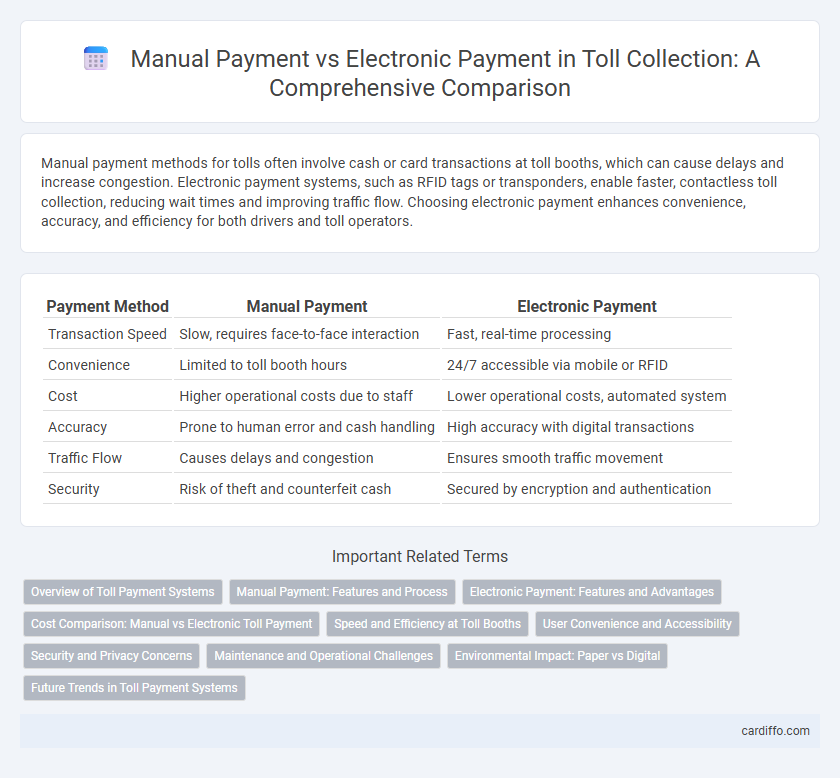Manual payment methods for tolls often involve cash or card transactions at toll booths, which can cause delays and increase congestion. Electronic payment systems, such as RFID tags or transponders, enable faster, contactless toll collection, reducing wait times and improving traffic flow. Choosing electronic payment enhances convenience, accuracy, and efficiency for both drivers and toll operators.
Table of Comparison
| Payment Method | Manual Payment | Electronic Payment |
|---|---|---|
| Transaction Speed | Slow, requires face-to-face interaction | Fast, real-time processing |
| Convenience | Limited to toll booth hours | 24/7 accessible via mobile or RFID |
| Cost | Higher operational costs due to staff | Lower operational costs, automated system |
| Accuracy | Prone to human error and cash handling | High accuracy with digital transactions |
| Traffic Flow | Causes delays and congestion | Ensures smooth traffic movement |
| Security | Risk of theft and counterfeit cash | Secured by encryption and authentication |
Overview of Toll Payment Systems
Toll payment systems have evolved from manual cash collections at toll booths to advanced electronic toll collection (ETC) using RFID, transponders, or license plate recognition technology. Manual payment requires drivers to stop and pay toll operators, causing delays and increasing operational costs, while electronic payment enables seamless, contactless transactions that improve traffic flow and reduce congestion. Electronic toll payment systems integrate with mobile apps and automated billing, offering greater convenience and real-time transaction tracking compared to traditional manual methods.
Manual Payment: Features and Process
Manual payment at toll booths involves cash or card transactions processed by an attendant or a kiosk, requiring physical interaction. The process typically includes stopping at the toll point, handing over payment, and receiving a receipt, which may cause delays compared to electronic methods. This method supports users without electronic toll tags or accounts but is less efficient during peak traffic hours.
Electronic Payment: Features and Advantages
Electronic payment systems offer seamless toll transactions through RFID tags, license plate recognition, and mobile apps, reducing congestion and wait times at toll plazas. They enhance accuracy and convenience by automatically deducting fees from linked accounts, minimizing human error and the need for cash handling. Integration with GPS and real-time data ensures efficient route management and improved traffic flow for commuters.
Cost Comparison: Manual vs Electronic Toll Payment
Manual toll payments generally incur higher costs due to labor-intensive processes, cash handling, and slower transaction times leading to increased operational expenses. Electronic toll payments reduce costs by automating transactions, minimizing labor requirements, and lowering infrastructure maintenance through efficient RFID and GPS technologies. Studies indicate electronic payment systems can reduce toll collection costs by up to 70% compared to manual methods, improving overall fiscal efficiency for toll operators.
Speed and Efficiency at Toll Booths
Electronic payment systems at toll booths significantly enhance speed and efficiency by enabling vehicles to pass without stopping, reducing congestion and wait times. Manual payment methods require cash handling and transaction processing, leading to slower throughput and increased potential for errors. Implementing electronic toll collection (ETC) technologies like RFID or automated license plate recognition streamlines operations and improves traffic flow.
User Convenience and Accessibility
Manual payment methods at toll booths offer users straightforward access without the need for technology, ensuring inclusivity for those without electronic devices or bank accounts. Electronic payments provide enhanced convenience through seamless transactions, reducing wait times and eliminating cash handling. Combining both options maximizes accessibility, catering to diverse user preferences and improving overall toll experience.
Security and Privacy Concerns
Manual toll payments expose users to higher risks of data theft and fraudulent activities due to physical handling of cash and paper receipts. Electronic toll payments utilize encrypted data transmission and tokenization, significantly enhancing security and protecting personal information from unauthorized access. Despite improved safeguards, electronic systems require constant updates to counter emerging cyber threats and maintain user privacy compliance.
Maintenance and Operational Challenges
Manual toll payment systems often demand extensive maintenance due to physical equipment wear and frequent cash handling discrepancies, leading to increased operational challenges and labor costs. Electronic payment systems streamline operations by reducing mechanical failures and minimizing human error, resulting in lower maintenance requirements and more efficient toll processing. However, network outages and system software updates remain critical considerations for ensuring seamless electronic toll collection performance.
Environmental Impact: Paper vs Digital
Manual toll payments generate significant paper waste from tickets and receipts, contributing to deforestation and increased landfill use. Electronic toll payments reduce the reliance on paper, lowering carbon emissions associated with production and disposal processes. Transitioning to digital systems supports sustainable transportation infrastructure by minimizing environmental footprints linked to toll operations.
Future Trends in Toll Payment Systems
Future trends in toll payment systems emphasize the shift from manual payment methods to fully electronic toll collection (ETC) systems, leveraging RFID technology and automatic license plate recognition (ALPR) for seamless transactions. Integration with mobile payment platforms and vehicle-to-infrastructure (V2I) communication enhances real-time toll processing and reduces congestion. Advances in blockchain and AI-driven fraud detection further ensure secure, efficient toll payments in smart transportation networks.
Manual payment vs electronic payment Infographic

 cardiffo.com
cardiffo.com